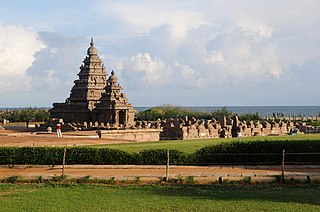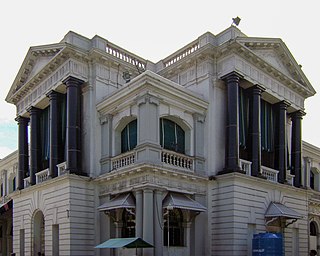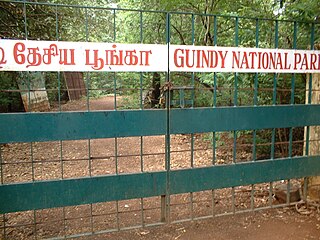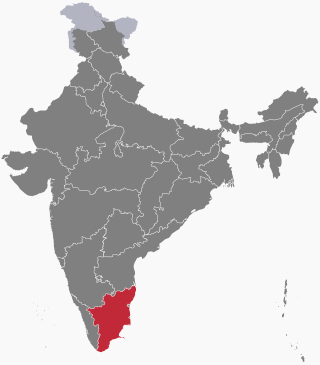
Tamil Nadu is the southernmost state of India. The tenth largest Indian state by area and the sixth largest by population, Tamil Nadu is the home of the Tamil people, who speak the Tamil language, one of the longest surviving classical languages and serves as its official language. The capital and largest city is Chennai.

Fort St. George is a fortress at the coastal city of Chennai, India. Founded in 1639, it was the first English fortress in India. The construction of the fort provided the impetus for further settlements and trading activity, in what was originally an uninhabited land. Thus, it is a feasible contention to say that the city evolved around the fortress. The fort currently houses the Tamil Nadu legislative assembly and other official buildings.

Chennai, formerly known as Madras, is the capital of the state of Tamil Nadu and is India's fifth largest city. It is located on the Coromandel Coast of the Bay of Bengal. With an estimated population of 8.9 million (2014), the 383-year-old city is the 31st largest metropolitan area in the world.
The flora and fauna of Chennai are the plants and animals in Chennai, India.

Chennai district, formerly known as Madras district, is one of the 38 districts in the state of Tamil Nadu, India. It is the smallest and the most densely populated district in the state. The district is coterminous with the city of Chennai, which is administered by the Greater Chennai Corporation. It is surrounded by Tiruvallur district in the north and the west, Kanchipuram district in the south-west, Chenglpattu district in the south, and the Bay of Bengal in the east.

Guindy National Park is a 2.70 km2 (1.04 sq mi) protected area of Tamil Nadu, located in Chennai, India, is the 8th-smallest National Park of India and one of the very few national parks situated inside a city. The park is an extension of the grounds surrounding Raj Bhavan, formerly known as the 'Guindy Lodge', the official residence of the governor of Tamil Nadu, India. It extends deep inside the governor's estate, enclosing beautiful forests, scrub lands, lakes and streams.

Guindy is a neighborhood of Chennai, Tamil Nadu. The Kathipara junction where Anna Salai, Mount-Poonamallee Road, Inner Ring Road, 100 Feet Road or Jawaharlal Nehru Road, and GST Road meet here. It is one of the important nodal points of road traffic in the metropolitan area. It is also a commercial hub. Here is headquarters of Ashok Leyland This junction serves as the entry point to the city limits from the suburbs. It is surrounded by Saidapet in the North, Kotturpuram and Adyar towards the East, Velachery in the South, Adambakkam and Alandur in the South-West, Parangimalai in the West and Ekkatutthangal in the North-West. Guindy is home to many important landmarks in the city, the most famous amongst them being the Guindy National Park. It also serves as a main hub for several small and medium scale industries. Transportation to/from the neighborhood is catered by Guindy railway station and Guindy metro station.

Chennai architecture is a confluence of many architectural styles. From ancient Tamil temples built by the Pallavas, to the Indo-Saracenic style of the colonial era, to 20th-century steel and chrome of skyscrapers. Chennai has a colonial core in the port area, surrounded by progressively newer areas as one travels away from the port, punctuated with old temples, churches and mosques.
Raj Bhavan of Ooty is the Summer residence of the Governor of Tamil Nadu, It is located in the city of Ooty, Tamil Nadu.

Anna Salai, formerly known as St. Thomas Mount Road or simply Mount Road, is an arterial road in Chennai, India. It starts at the Cooum Creek, south of Fort St George, leading in a south-westerly direction towards St. Thomas Mount, and ends at the Kathipara Junction in Guindy. Beyond the Kathipara Junction, a branch road arises traversing westwards to Poonamallee to form the Mount-Poonamallee Road while the main branch continuing southwards to Chennai Airport, Tambaram and beyond to form Grand Southern Trunk Road. Anna Salai, which is more than 400 years old, is acknowledged as the most important road in Chennai city. The head offices of many commercial enterprises and public buildings are located along Anna Salai. It is the second longest road in Chennai, after EVR Periyar Salai.

The Tamil Nadu Dr. M.G.R. Medical University is a government medical university situated in Guindy in the southern part of the city of Chennai, Tamil Nadu, India. It is about 7 km (4.3 mi) from the Chennai International Airport and about 13 km (8.1 mi) from the Puratchi Thalaivar Dr. M.G. Ramachandran Central Railway Station. It is one of the premier medical universities in India, named after the former Chief Minister of Tamil Nadu M. G. Ramachandran (M.G.R.) and it is the second largest health sciences university in India after Rajiv Gandhi University of Health Sciences, Karnataka.
Beri Thimappa / Thimmanna was an Indian interpreter and chief negotiator for Francis Day and Andrew Cogan, the agents of the British East India Company, and was instrumental in the purchase of Madras from the Nayak brothers. Beri Thimmappa migrated in the early 17th century to Chennai from palakollu, near Machilipatnam in Andhra Pradesh. He established a Black Town outside the walls of the newly built Fort of Madras which later became Fort St George.

Pulicat Lake Bird Sanctuary is a sanctuary for birds, 759 km2 in area, located in the Tirupati district of Andhra Pradesh and a protected area of the Thiruvallur District of Tamil Nadu, India. Pulicat Lake is the second largest brackish-water eco-system in India after Chilka lake in Orissa. The sanctuary's international name is Pulicat Lake Wildlife Sanctuary.

Sardar Patel Road is an arterial road in Chennai which runs from Mount Road eastwards through Guindy and Adyar for 3.2-kilometre (2.0 mi) up to the sea coast where it turns north and crosses the Adyar River to Raja Annamalaipuram.

Sir William Langhorne, 1st Baronet was the Agent of Madras from January 1670 to 27 January 1678.
Chinnamalai, translated in English as Little Mount, is a small hillock that lies on the bank of Adayar River in the Saidapet taluk of Chennai, Tamil Nadu, India. Anna Salai, previously called Mount Road, is a long road in Chennai that stretches between Chennai northern side to the southern side at Little Mount. To access pedestrians crossing the roads in Little Mount in an easy manner, a foot over bridge is proposed to be constructed 100 m away from the already existing walkway bridge, by the State Highways department of Tamil Nadu.

The following outline is provided as an overview of and topical guide to Tamil Nadu:
Raj Bhavan, Tamil Nadu may refer to:














